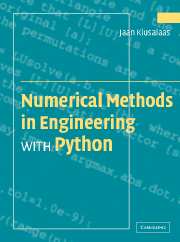Book contents
- Frontmatter
- Contents
- Preface
- 1 Introduction to Python
- 2 Systems of Linear Algebraic Equations
- 3 Interpolation and Curve Fitting
- 4 Roots of Equations
- 5 Numerical Differentiation
- 6 Numerical Integration
- 7 Initial Value Problems
- 8 Two-Point Boundary Value Problems
- 9 Symmetric Matrix Eigenvalue Problems
- 10 Introduction to Optimization
- Appendices
- Index
8 - Two-Point Boundary Value Problems
Published online by Cambridge University Press: 05 June 2012
- Frontmatter
- Contents
- Preface
- 1 Introduction to Python
- 2 Systems of Linear Algebraic Equations
- 3 Interpolation and Curve Fitting
- 4 Roots of Equations
- 5 Numerical Differentiation
- 6 Numerical Integration
- 7 Initial Value Problems
- 8 Two-Point Boundary Value Problems
- 9 Symmetric Matrix Eigenvalue Problems
- 10 Introduction to Optimization
- Appendices
- Index
Summary
Solve y″ = f(x, y, y′), y(a) = α, y(b) = β
Introduction
In two-point boundary value problems the auxiliary conditions associated with the differential equation, called the boundary conditions, are specified at two different values of x. This seemingly small departure from initial value problems has a major repercussion—it makes boundary value problems considerably more difficult to solve. In an initial value problem we were able to start at the point where the initial values were given and march the solution forward as far as needed. This technique does not work for boundary value problems, because there are not enough starting conditions available at either end point to produce a unique solution.
One way to overcome the lack of starting conditions is to guess the missing values. The resulting solution is very unlikely to satisfy boundary conditions at the other end, but by inspecting the discrepancy we can estimate what changes to make to the initial conditions before integrating again. This iterative procedure is known as the shooting method. The name is derived from analogy with target shooting—take a shot and observe where it hits the target, then correct the aim and shoot again.
Another means of solving two-point boundary value problems is the finite difference method, where the differential equations are approximated by finite differences at evenly spaced mesh points. As a consequence, a differential equation is transformed into set of simultaneous algebraic equations.
- Type
- Chapter
- Information
- Numerical Methods in Engineering with Python , pp. 295 - 323Publisher: Cambridge University PressPrint publication year: 2005

